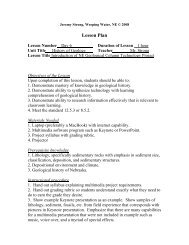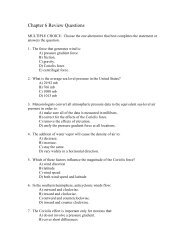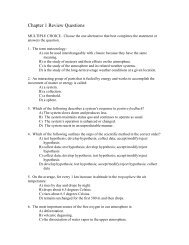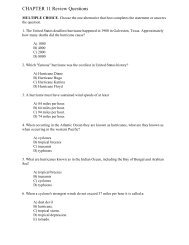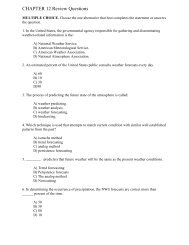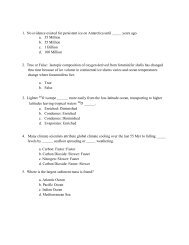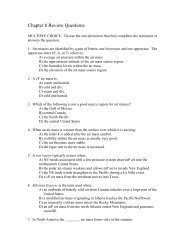Chapter 4 Review Questions - UNL | Earth and Atmospheric Sciences
Chapter 4 Review Questions - UNL | Earth and Atmospheric Sciences
Chapter 4 Review Questions - UNL | Earth and Atmospheric Sciences
- No tags were found...
You also want an ePaper? Increase the reach of your titles
YUMPU automatically turns print PDFs into web optimized ePapers that Google loves.
<strong>Chapter</strong> 4 <strong>Review</strong> <strong>Questions</strong>MULTIPLE CHOICE: Choose the one alternative that best completes the statement oranswers the question.1. A large temperature lapse rate would occur in a layer with:A) uniformly cold temperatures throughout.B) cold air above, warm air below.C) warm air above, cold air below.D) uniformly warm temperatures throughout.2. About what percent of <strong>Earth</strong>’s water can be found in the oceans?A) 97 percentB) 90 percentC) 70 percentD) 53 percent3. Why does a rising air parcel cool off?A) Its relative humidity is less than 100 percent.B) It loses heat to its surroundings.C) It loses energy by radiation.D) It exp<strong>and</strong>s.E) It is unstable.4. Which of the following processes requires the highest release of energy from the watermolecules?A) meltingB) freezingC) condensationD) deposition5. When the dry <strong>and</strong> wet bulb temperatures measured by a psychrometer are equal, allbut one of the following is true. Which one is false?A) A rise in temperature would cause condensation.B) The air is saturated.C) Water vapor content is a maximum.D) Relative humidity is 100 percent.E) Dew point is equal to the dry bulb.6. The amount of water vapor in the air (by volume) usually does not exceed:A) 4 percentB) 14 percentC) 100 percentD) 28 percentE) 40 percent
7. If air at sea level with a temperature of 27 degrees C is forced up a mountain slope <strong>and</strong>the air’s dew point at the condensation level is 14 degrees C, at what elevation willcondensation begin?A) 2700 metersB) 1300 metersC) 1400 metersD) 2600 meters8. The moist adiabatic rate is different from the dry adiabatic rate because:A) an unstable air parcel exp<strong>and</strong>s more rapidly.B) latent heat is released inside a parcel of rising saturated air.C) saturated air is always unstable.D) a parcel of saturated air weighs less than a parcel of unsaturated air.E) unsaturated air is always stable.9. If your environmental lapse rate is -7 C/km on a partly cloudy afternoon, then theatmosphere is said to be:A) absolutely stable.B) absolutely unstable.C) conditionally stable.10. If your environmental lapse rate is 17 C/km on a partly cloudy afternoon, then theatmosphere is said to be:A) absolutely unstable.B) absolutely stable.C) conditionally stable.11. An inversion represents an extremely stable atmosphere because a parcel of air thatrises into an inversion will eventually become _______ <strong>and</strong> ________ dense than the airsurrounding it.A) colder, lessB) colder, moreC) warmer, lessD) warmer, more12. These two conditions, working together, will make the atmosphere the most unstable.A) warm the surface <strong>and</strong> warm the air aloftB) warm the surface <strong>and</strong> cool the air aloftC) cool the surface <strong>and</strong> warm the air aloftD) cool the surface <strong>and</strong> cool the air aloft13. The atmosphere is most unstable when the temperature of the air _________ withheight.A) is uniformB) drops rapidlyC) increases slightly
D) decreases slightlyE) increases rapidly14. Adiabatic processes are only important for air:A) masses which remain near the <strong>Earth</strong>’s surface.B) that is saturated.C) that is polluted.D) that is stagnant.E) which is rising or sinking.15. During the process of adiabatic cooling, the temperature decreases because the airhas:A) been compressed.B) lost heat to the colder air at higher altitudes.C) lost some of its water vapor.D) exp<strong>and</strong>ed to a larger volume.E) emitted infrared radiation.16. The property which primarily controls how much water can be present as a gas is:A) a number of particulates present.B) availability of latent heat.C) temperature of the air.D) water’s specific heat.E) amount of dry air gases present.17. Assume that the actual vapor content of the air remains constant over the course ofthe day. How does the relative humidity at 2:00 p.m. probably compare to the relativehumidity at 5:00 a.m.?A) The relative humidity at 2:00 p.m. is higher.B) The relative humidity at 2:00 p.m. is lower.C) The relative humidity is the same at 2:00 p.m. as at 5:00 a.m.18. Which of the following requires the GREATEST RELEASE of latent heat energyinto the atmosphere?A) melting of 1 gram of waterB) freezing of 1 gram of waterC) evaporation of 1 gram of waterD) condensation of 1 gram of water19. The air in Great Falls, Montana has a temperature of 5°C <strong>and</strong> a relative humidity of50 percent. On the same afternoon, the air in Palm Springs, California has a temperatureof 25°C <strong>and</strong> a relative humidity of 50 percent. What can be said about the amount ofvapor in the air at these two cities?A) Palm Springs will have a higher vapor content than Great Falls.B) Great Falls will have a higher vapor content than Palm SpringsC) Great Falls <strong>and</strong> Palm Springs will have the same vapor content.
20. Water vapor constitutes about this much of the atmosphere by volume.A) 0-4 percentB) 0-12 percentC) 0-100 percentD) 4-25 percentE) 4-12 percent




